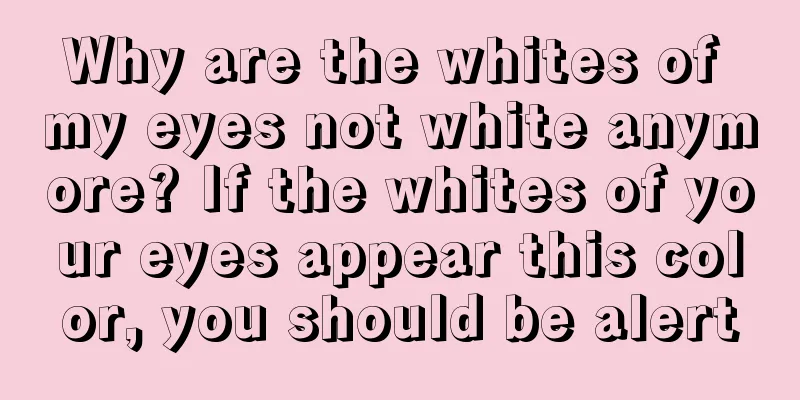Why are the whites of my eyes not white anymore? If the whites of your eyes appear this color, you should be alert

|
We all know the whites of the eyes, but in medicine the whites of the eyes are also called sclera. The whites of the eyes reflect a person's health, and the color of the whites of the eyes is closely related to the health of the human body. Especially as people age, many people's eyes become cloudy and not as clear, and sometimes they appear blue or red. At this time, you should pay special attention to see if it is caused by a lack of certain elements in the body. So what should you do if the whites of your eyes are not white? 1. Blue whites of the eyes - anemia Some people's whites of the eyes are not porcelain white, for example, the whites of the eyes are blue, which is medically called blue sclera. If the whites of your eyes are blue, it means that your body lacks iron. This is because the human sclera is composed of collagen tissue, and the synthesis factors of collagen tissue include iron. Most people with blue whites of their eyes suffer from chronic iron deficiency anemia. Such people can take iron supplements or improve their nutrition through diet therapy. If the whites of a child's eyes are blue, it can basically be considered as anemia. 2 Red spots on the whites of the eyes - diabetes There are red spots on the whites of the eyes, which are the result of dilation of the ends of capillaries. This situation usually occurs in diabetic patients. Patients diagnosed with diabetes should pay more attention to their eyes. There are many eye complications of diabetes, such as cataracts and diabetic retinopathy. However, many diabetics do not know this and have no awareness of regular check-ups. It is recommended that diabetics pay attention not only to the color of the whites of their eyes, but also to changes in vision. 3 Yellowing of the whites of the eyes – jaundice If the whites of a newborn's eyes turn yellow, it is jaundice. If it is an adult, there are mainly two situations: one is abnormal liver function, increased bilirubin in the blood, and yellowing of the whites of the eyes. This type of yellowing is a uniform yellowing of the whites of the eyes; the second type is caused by high blood lipids. This yellowing is localized and a bit blackish. Also seen in icteric hepatitis or cholestatic hepatitis. Infectious liver disease, biliary tract disease, pregnancy poisoning and some hemolytic diseases can also cause it. If the whites of adults’ eyes turn yellow, they need to adjust their lifestyle habits. Don't drink alcohol, don't eat spicy food, and try to eat a light diet. 4 Blood flakes appear in the white of the eye——arteriosclerosis Elderly people are more likely to have blood clots on the whites of their eyes, which is a sign of arteriosclerosis. Arteriosclerosis is one of the important causes of death among the elderly, and old men suffer from it more often than old women. If blood stains appear on the whites of the elderly’s eyes, they should pay attention to monitoring their blood pressure and blood lipids, and also strictly avoid eating foods with high cholesterol and greasy foods. 5 Gray and black spots - roundworms If gray or black spots appear on the whites of your eyes, and they are triangular, circular, or half-moon shaped, it means you have roundworms and you need to get rid of them! It is sufficient for adults to deworm 1-2 times a year, usually in spring and autumn. |
<<: What kind of medicine should I use to clean my eyes?
>>: How to treat ocular sweat adenoma
Recommend
Three signals from both feet reveal life span
The feet are at the bottom of our body, so many p...
What is the correct method of artificial respiration
We all know that when a patient faints and needs ...
The efficacy and function of the fortune tree
The money tree is deeply loved by people because ...
What is the reason for high serum uric acid?
What causes high serum uric acid? Usually, people...
What diseases will occur if pharyngitis becomes serious
I believe many people are very familiar with the ...
Why does my legs hurt when the wind blows?
If your legs don't normally hurt, but they hu...
The best time for running in autumn
Nowadays, the awareness of national fitness is mu...
How to treat scar tissue
Scars are a particularly stubborn disease. Patien...
How to treat esophagitis, gastroenteritis and superficial gastritis
Esophagitis, gastroenteritis and superficial gast...
What are the dangers of subcutaneous lipoma? Will it become malignant?
The most common sites for subcutaneous lipomas ar...
Is a cylindrical pillow good for the cervical spine?
In the medical field, it is believed that the cli...
Corn pest and disease control
Corn is the most common crop in rural Northeast C...
Which one is better for reducing internal heat, white sugar or rock sugar?
In daily life, we often encounter three types of ...
Is cherry hot and humid?
Damp-heat is a term used in traditional Chinese m...
Do color blind glasses work?
Color blindness is an eye disease and is relative...









